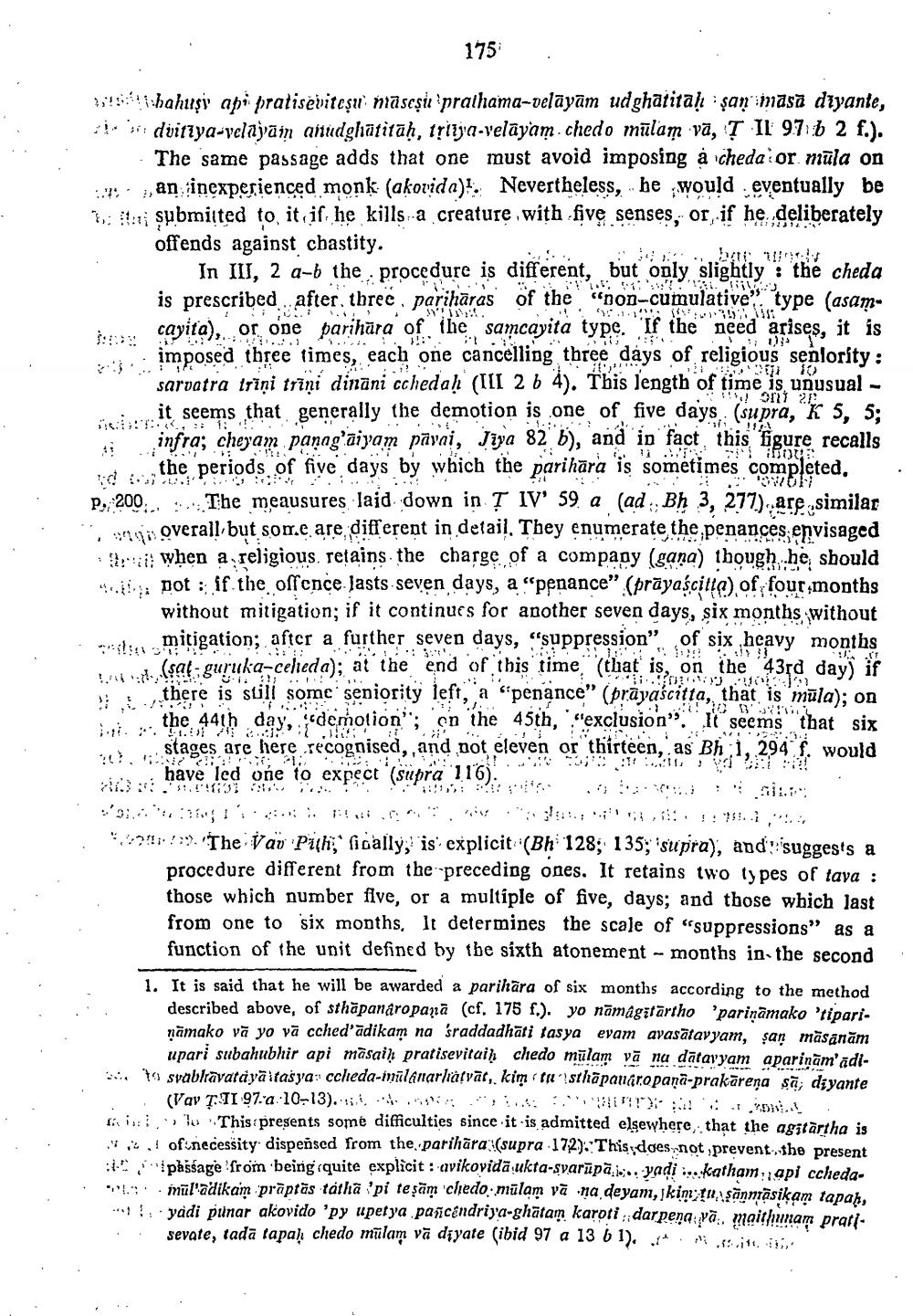________________
175
%, hahuşi ani pratisèviteșu naseși prathama-velāyām udghatitah şan masă diyante, 13 dviriya-velayain anudghātirah, trilya-velayam. chedo mīlam vā, Ţ II 9710 2 f.).
The same passage adds that one must avoid imposing a cheda or mūla on *. , an inexperienced monk (akovida). Nevertheless, he would eventually be 7, ili şubmiited to it, if he kills a creature with five senses, or, if he deliberately offends against chastity.
In III, 2 a-b the procedure is different, but only slightly : the cheda is prescribed, after three parihāras of the non-cumulative type (asam
cayita), or one parihāra of the samcayita type. If the need arises, it is W e imposed three times, each one cancelling three days of religious seniority:
sarvatra trīņi trīņi dināni cchedaḥ (III 2 b 4). This length of time is unusual – ... it seems that generally the demotion is one of five days (supra, "K 5. 5:
infra; cheyam panag’aiyam pāvai, Jiya 82 b), and in fact this figure recalls
the periods of five days by which the parihāra is sometimes completed. . p. 200. The meausures laid down in Ţ IV' 59. a (ad, Bh 3, 277)..are similar og overall, but some are different in detail. They enumerate the penances envisaged
is when a religious. retains the charge of a company (gana) though he should I pot : if the offence. Jasts-seven days, a “penance" (prāyaścitta), of four months
without mitigation; if it continues for another seven days, six months without de mitigation; after a further seven days, “suppression" of six heavy months
(sat: guruka-ceheda); at the end of this time (that is, on the 43rd day) if . , there is still some seniority left, a "penance" (prāyaścitta, that is mūla): on .the 441h day, demolion'; on the 45th, "exclusion". It seems that six
stages are here recognised, and not eleven or thirteen, as Bh 1, 294 f, would have led one to expect (supra 116)
Hot
.
!!
!!
!
$:.!!437 :15
.
.
:
,:!!!?). "The Vav Pidhi' fically, is: explicit (Bh 128; 135; 'supra), and suggests a
procedure different from the preceding ones. It retains two types of taya : those which number five, or a multiple of five, days; and those which last from one to 'six months, It determines the scale of "suppressions as a function of the unit defined by the sixth atonement - months in the second
1. It is said that he will be awarded a parihara of six months according to the method
described above, of sthapanaropanā (cf. 175 f.). yo namagitārtho 'parināmako 'tipari. nämako vā yo vä сched'adikam na sraddadhāti tasya evam avasātavyam, şan māsanām
upari subahubhir api māsaih pratisevitai) chedo mīlam vā nu dātayyam aparinām'adi2. to svablrävata yä tasya: ccheda-imīlanarliavār, kim til sthapanaropana-prakāreņa sā; diyante
Vay TTI 97a 10-13). ti • , , , , , , , , ,{i !!!! :: : : ::.. .
10 This presents some difficulties since it is admitted elsewhere that the agitārtha is of necessity dispensed from the.parihāra:(supra 172). This does not prevent the present
passage from being (quite explicit : avikovida ukta-svarūpā.is, yadi....katham api ccheda.. mulladikam prāptās tatha 'pi teşām chedo: mūlam vāna deyam,Ikin tasanmasikam tapah.
yadi punar akovido 'py upetya pancêndriya-ghātam karoti, dar pena ya maithunam pratisevate, tada tapah chedo milam va diyale (ibid 97 a 13 61). . Hit




